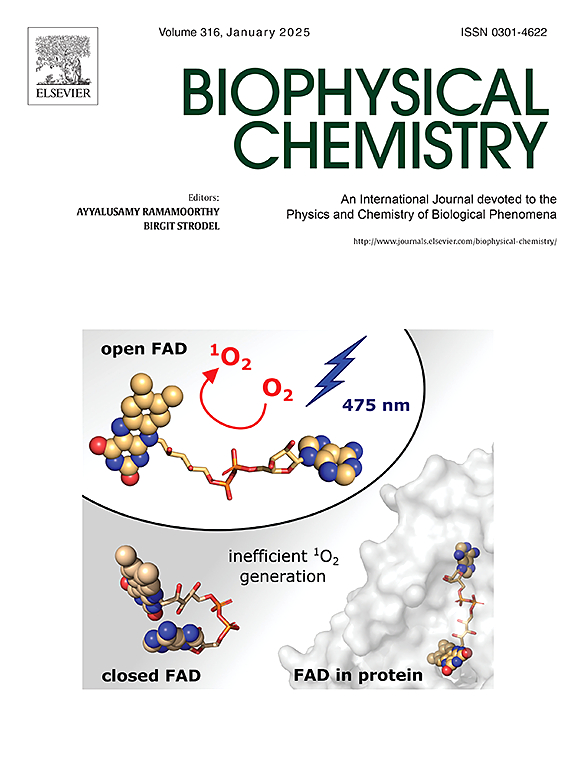天然白蛋白和聚集白蛋白与DMPC双层的相互作用
IF 2.2
3区 生物学
Q2 BIOCHEMISTRY & MOLECULAR BIOLOGY
引用次数: 0
摘要
蛋白质-脂质相互作用的研究为超分子复合物形成过程中确定的相互改变提供了有趣的见解。当涉及蛋白质聚集和纤维形成时,不仅在基础研究中,而且在生物医学和生物材料应用中,它获得了更多的兴趣。本研究通过紫外-可见散射、衰减全反射傅立叶变换红外(ATR-FTIR)和自旋标记电子顺磁共振(EPR)光谱,研究了天然和热聚集状态下的人血清白蛋白(HSA)和二酰基磷脂酰胆碱(DMPC)双分子层的相互影响。固定波长下温度相关的光密度揭示了DMPC双分子层的前相变和主相变以及tag≈70°C时蛋白质聚集的开始。在天然蛋白/脂质复合物中,膜表面的蛋白质吸附抑制了DMPC的预转变并降低了DMPC的主要相变温度,而DMPC的存在增加了Tagg,但不影响热剖面。动力学实验表明,脂质双分子层减少了热诱导的蛋白质聚集。ATR-FTIR数据表明,白蛋白削弱了膜羰基上的氢键网络。相反,任何物理状态下的脂质双分子层都不会改变天然和聚集的HSA的结构特征。在蛋白/脂质复合物中,脂质组分的自旋标记EPR表明,蛋白质降低了第一链段的堆积密度,稳定了流体状态,对天然蛋白的作用更为明显。本文章由计算机程序翻译,如有差异,请以英文原文为准。

Interaction of native and aggregated albumin with DMPC bilayers
The study of protein-lipid interaction offers interesting insights into the mutual alterations determined in the formation of the supramolecular complex. It gains even more interest, not only in basic research but also in biomedical and biomaterial applications, when protein aggregation and fibril formation are involved. In this study, the reciprocal influence of human serum albumin (HSA), in both the native and the thermally aggregated state, and dimyristoylphosphatidylcholine (DMPC) bilayers is investigated by combining UV–Vis scattering, attenuated total reflection Fourier transform infrared (ATR-FTIR), and spin-label electron paramagnetic resonance (EPR) spectroscopies. Temperature-dependent optical density at fixed wavelength reveals the pre- and the main phase transitions in DMPC bilayers as well as the onset of protein aggregation at Tagg ≈ 70 °C. In native protein/lipid complexes, the protein adsorption on the membrane surfaces suppresses the pre-transition and downshifts the temperature of the main phase transitions of DMPC, whereas the presence of DMPC increases Tagg without affecting the thermal profile. Kinetics experiments reveal that lipid bilayers reduce the thermally-induced aggregation of the protein. ATR-FTIR data indicate that albumin weakens the hydrogen bonding network at the carbonyl groups of the membrane. Conversely, lipid bilayers in any physical state do not alter the structural features of both native and aggregated HSA. In protein/lipid complexes, spin-label EPR of the lipid component reveals that the proteins reduce the packing density of the first chain segments and stabilize the fluid state, the effect being more evident for the native protein.
求助全文
通过发布文献求助,成功后即可免费获取论文全文。
去求助
来源期刊

Biophysical chemistry
生物-生化与分子生物学
CiteScore
6.10
自引率
10.50%
发文量
121
审稿时长
20 days
期刊介绍:
Biophysical Chemistry publishes original work and reviews in the areas of chemistry and physics directly impacting biological phenomena. Quantitative analysis of the properties of biological macromolecules, biologically active molecules, macromolecular assemblies and cell components in terms of kinetics, thermodynamics, spatio-temporal organization, NMR and X-ray structural biology, as well as single-molecule detection represent a major focus of the journal. Theoretical and computational treatments of biomacromolecular systems, macromolecular interactions, regulatory control and systems biology are also of interest to the journal.
 求助内容:
求助内容: 应助结果提醒方式:
应助结果提醒方式:


